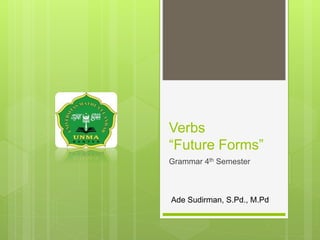
Verbs, part 2 (Ade Sudirman)
- 1. Verbs “Future Forms” Grammar 4th Semester Ade Sudirman, S.Pd., M.Pd
- 2. The be going to future Use : To express intention. The speaker had the intention before the time of speaking: I’m going to visit Bob tomorrow. To make a prediction based on present evidence: The sun’s going down. It’s going to be dark in half an hour.
- 3. Present continuous as future Use: To describe arrangements. To talk about the future when the plans have been made. It is quite informal and is used to describe personal arrangements such as social activities rather than official plans, so the subject of the verb should be a person or people not a thing: I’m meeting Charlotte for lunch tomorrow.
- 4. Contrast be going to future VS present continuous as future I’m going to visit my aunt in hospital tomorrow. I’m visiting my aunt in hospital tomorrow. Look at that helicopter coming down. It’s going to land in a minute. Look at that helicopter coming down. It’s landing in a minute He’s having a swim. He’s going to have a swim. Intention arrangement
- 5. Future with “will” Use: To make a statement of fact or prediction about the future: Sam will be there tomorrow. To make formal announcements of future plans and to present weather forecast: Rain will continue throughout the day. To express hopes, expectations, thoughts about the future: I expect they’ll be here soon.
- 6. Future with “will” (cont…) Use: In sentence containing clauses of condition or time: I’ll phone you when I get there To express an intention when the decision is made at the time of speaking: Oh, isn’t there? I‘ll get some in town. I’m going there later on. To express the idea of willingness: I’ll do it for you. To make offers or suggestions or to ask suggestions, advice, instructions: Shall I help you with that?
- 7. Contrast be going to VS will Intention: Be going to : the intention is premeditated. The decision was made before the time of speaking or writing and plans have probably already been made: A: You know it’s Emily’s birthday on Friday, don’t you? B: Yes, I’m going to buy her a present at this afternoon.
- 8. Intention (cont…) Will : the intention is unpremeditated. The decision is made at the time of speaking or writing. A: You know it’s Emily’s birthday on Friday, don’t you? B: Actually I’d forgotten. Thanks for reminding me. I’ll buy her a present this afternoon.
- 9. Contrast Prediction Be going to: the prediction is based on some form of evidence that exists in the present. Oh look! That car is going to crush. Will: to express beliefs, hopes, thoughts, assumption, and doubts about the future: It’ll be a difficult year for the new Prime Minister.
- 10. Simple present as future Use: We use simple present to refer to the future in clauses of time and condition: We’ll phone you when we get there. Please wait here until I get back. We can use simple present to refer to future events when the event is part of fixed timetable: The flight leaves at 6 o’clock in the morning.
- 11. Future Continuous Use: To describe an activity that will be in progress at a point in the future. This tome tomorrow we’ll be sitting on the plane. To describe an activity that will cover the whole of a future time period. I’ll be working in the office all evening.
- 12. Future Continuous (cont…) To describe a future event without expressing deliberate intention. I’ll be seeing him at the music club tonight so I’ll give it to him for you. To describe what we assume someone else is doing at this moment. Don’t phone her now. It’s 4 o’clock and she’ll be collecting the children from school.
- 13. Contrast future continuous VS will future Will future: express intention, belief, hope, assumption and willingness. I’ll come and visit you tomorrow. Future continuous: Indicates future activity or event but does not express intention or willingness. I’ll be coming to visit you tomorrow so I can bring the magazine then.
- 14. Future Perfect and Continuous Use: We use the future perfect to say that, at a certain time in the future, something will be completed and be in the past. It is often used with by+ time reference: I’ll have finished this book by tomorrow. I’ll have told him the news by the time you get here.
- 15. Future Perfect and Continuous (cont…) We use the future perfect and continuous with for to talk about the duration of an activity or state up to a time in the future. We’ll have lived here for two years in January. She’ll have been working here for ten years soon. We use the future perfect continuous to describe an activity leading up to a time in the future. They might be tired when you see them because they’ll have been working hard.
- 16. Assignment 5 Practice 15, p.55; Practice 16, p.57; Practice 20, p. 65; Practice 21, p. 67. The end Thank you
